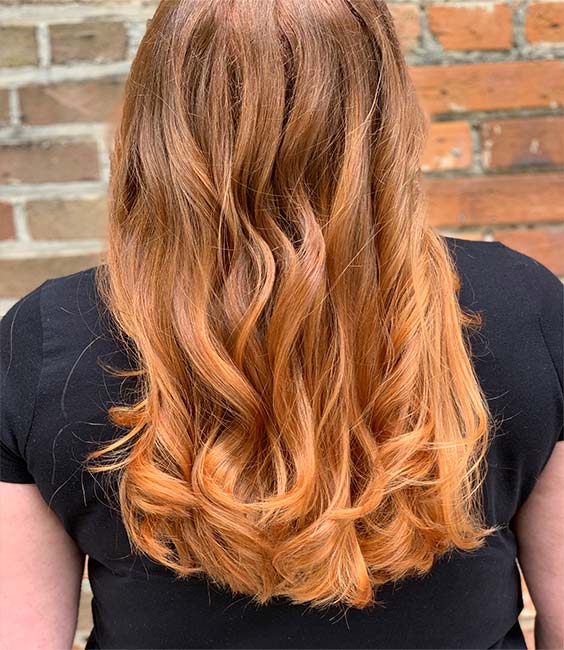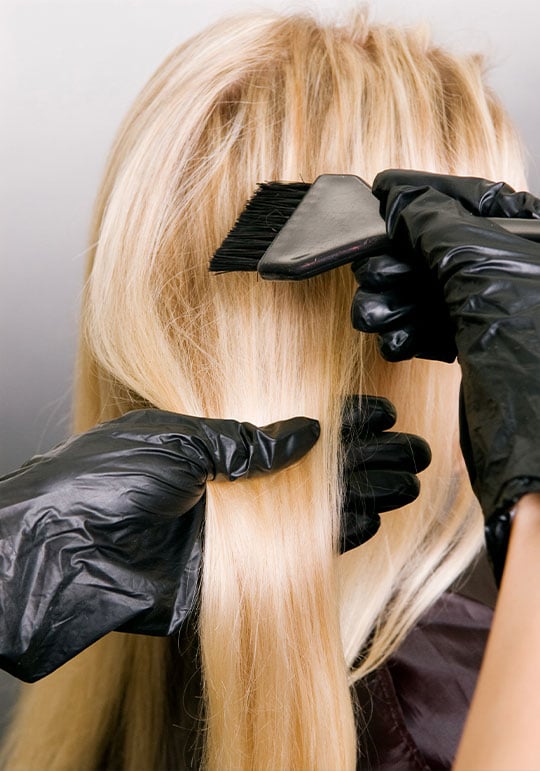

Choosing the right hair salon near St. George, SC, is a little bit like finding the perfect outfit. The materials feel great on your skin, the fabric is flattering to your body type, and when you try it on, you just know - this is the outfit that you have been looking for.
With thousands of hair salons and stylists in South Carolina, choosing the right one can be difficult. You want a salon that is clean, comfortable, and chic. But, more importantly, you need a stylist that "gets" you. Someone who takes the time to understand your preferences, your style, and your personality. You need a stylist who listens, is honest, and has the technical skills to turn your vision into a reality.
An excellent stylist epitomizes all those traits and knows how to adapt to changing beauty trends. They aren't afraid to take on a challenge.

Where the most talented hairstylists near St. George help bring out the beauty in each of our clients. We strive to provide each of our customers with the highest levels of customer service in the beauty industry. At Chroma, we offer a relaxing environment, skillful professionals, and a variety of products with environmentally safe and good-for-you ingredients.
Our goal is to make your salon experience special, from the moment you walk in to the second you leave. With a variety of professional hair and beauty services to choose from, we're sure you will rediscover the "beauty of you" every time you visit our salon.
The key to a great haircut and salon experience is to understand the services we offer, so you can choose the best selection for your needs. What do our salon services entail? Keep reading below to find out.

Let's be honest: DIY hair kits can be tricky to get right. They can be complicated to apply and usually have hard-to-understand instructions. Half the time, the color you're left with looks nothing like it does on the front of the box. In a perfect world, you should be able to pop into Target, pick a boxed hair color, apply it at home, and emerge out of your bathroom with a new, beautiful hair color. For most people, this never happens.
That's why people who want flawless color, professional application, and ease of convenience get their highlights at Chroma Hair Studio & Spa.
Whether you are changing your hair color completely or just want a few highlights to switch things up, we are here to create the look and style that you've been dreaming about. At Chroma Hair Studio & Spa, we specialize in the latest hair coloring trends using cutting-edge technology. That way, our clients get the freshest looks, coolest colors, and longest-lasting highlights in town. When you get your highlights done at our hair salon near St. George, we want you to leave excited and ready to share your new hair all over social.
Don't spend hours in the store trying to find the color you think will look great on you. Our team of professional stylists will consult with you about your vision and craft a custom highlight plan that fits you're your unique style. There's a reason why so many customers trust us with their highlights - we genuinely care about your hair and how it looks.
Our professional hair coloring services near St. George are a combination of art and science. The artistic results only last as long as the hair coloring products used, and we use the best. Our hairstylists and colorists are committed to helping you look and feel fabulous, whether you're planning a special occasion or just want to impress that special someone.

Ever taken a chance on a new look or hair color, only to end up embarrassed and unsatisfied with the results? You're not alone - we get calls every week from people just like you who need hair treatment St. George. Sadly, sometimes even the professionals get a color procedure wrong.
Other times, your hair has suffered from years of blow-drying and straightening, and it looks dry, brittle, and unattractive. You know you need a deep conditioning treatment, and you need it ASAP.
At Chroma Hair Studio & Spa, our technicians have treated all sorts of hair problems - from unprofessional coloring with multiple bands of different colors and tones to dehydrated hair and more. Sometimes, our client's entire hairstyle needs to be corrected. To do this, we stock multiple types of color and toners to revitalize hair and give it the color you've been dreaming of. Our team always puts a priority on the health and integrity of your hair, whether it's your first visit or your fortieth.
Appointment Request
The Brazilian blowout: you've heard about the new craze, you've seen the stunning results, but haven't had a chance to sit down and receive the treatment yourself. Luckily, Chroma Hair Studio & Spa now offers this sought-after style right here near St. George, from certified Brazilian blowout stylists.
If you suffer from dull, frizzy hair that lacks life and shine, the Brazilian blowout is one of the best ways to get smooth, frizz-free hair. By using cutting-edge bonding technology, this customizable treatment doesn't damage your hair at all. Actually, it improves your hair's health by adding a protective layer of protein that smooths your hair for weeks on end.
This ultra-popular choice offers you a laundry list of benefits, like:
To get the best of both worlds, be sure to schedule your Brazilian blowout and custom hair color treatment in the same appointment. Call us today to learn more about our Brazilian blowouts and to schedule your appointment today.

There are many ways that you can reinvent yourself this season, but if you're ready to make a lasting impression, nothing beats a new hairstyle. While there is nothing wrong with sporting top knots, ponytails, or straight hair, a styled cut from Chroma Hair Studio & Spa will drastically improve your hair game.
Getting a new haircut isn't just fun - it makes you feel good, too, especially when you get a lot of positive compliments.

Our experienced stylists are tapped into today's hottest trends, so if you want to try something new, we're here to help. If you want to play it more traditional, our stylists have a solid foundation of time-tested techniques, to give your existing cut the edge it needs to impress. And sometimes, you need something simple and low-maintenance that cuts down on styling time and primping.
Not sure what kind of a cut you need? We're happy to give you our educated opinion and are happy to provide examples of what we think works. Whatever style you've got your eye on, we can make it a reality!

In a time when extravagant dyes and unique hair extensions are all the rage, the natural look will always be trending. This haircut is a great way to rediscover yourself and let your beauty shine organically without overdoing it.

This medium-length haircut is a classic throwback to the 79s, with a layered look, messy bangs, and lots of attitude. If you like to get ahead of trends before your friends, bring back the shag and rock this retro style with pride.

This cut will look great during the summer and will give you an innocent look that will get plenty of attention. Great for a short-term haircut or even something special for a big party or Gen-X event.

Go against the status quo and let your hair down this season. Pixie cuts and shags are all the rage, but rocking a Rapunzel-like haircut will set you apart from the crowd. If you're looking for a more natural, classic look, this could be your haircut.
If you're looking to switch up your hair color but can't decide between Balayage or Ombre because, well, you don't know the difference - don't worry. You're not alone!
Balayage is a French technique for highlighting the hair in which the dye is painted to create a natural-looking effect. The goal is to create soft, subtle highlights that make your hair look like it's been kissed by the sun.
While Balayage is the technique of painting the hair, Ombre focuses on the style of the hair. It is the transition from a lighter shade to a darker shade. Typically, Ombres work best for brunettes, but the style can is suitable for blondes too. To achieve the effect of an Ombre, there must be a smooth transition between colors. While the Ombre is a beautiful look, you'll need to work with a professional to get the best results.
Luckily, we offer both Ombre and Balayage near St. George, SC! Short on time? Busy schedule? Only available on weekends? Chroma Hair Studio & Spa offers flexible appointment scheduling to accommodate even the busiest clients. You deserve a fresh new style, and we're here to help when the time is right for you.
If you're looking for a hair salon that offers high-end styling without expensive pricing, you're in the right place. Our goal is to exceed your expectations and leave you feeling beautiful, whether you need a touch-up or a total makeover. We offer a relaxing salon atmosphere, skillful stylists, and only the best in professional brands. When it's time for your next haircut, highlight session, or eyelash extension, look no further than Chroma Hair Studio & Spa.
Appointment RequestST. GEORGE, S.C. (WCIV) — During the 1920s in the heart of the Jim Crow era, Black and white students were not allowed to go to school together. Unfortunately, white students had better quality schools and Black students would have to learn in schools that were almost falling apart.In 1915, Booker T. Washington and Julius Rosenwald, the owner of Sears, set out on a mission to fund and create better-quality schools for Black students. These schools became known as Rosenwald Schools.READ MORE:...
ST. GEORGE, S.C. (WCIV) — During the 1920s in the heart of the Jim Crow era, Black and white students were not allowed to go to school together. Unfortunately, white students had better quality schools and Black students would have to learn in schools that were almost falling apart.
In 1915, Booker T. Washington and Julius Rosenwald, the owner of Sears, set out on a mission to fund and create better-quality schools for Black students. These schools became known as Rosenwald Schools.
READ MORE: SC school helped educate Black students in segregated South. Could a national park follow?
Nearly 5,000 schools were created and became that paradise for young Black students who wanted to learn.
One of those schools currently sits in the heart of St. George: St. George Rosenwald School.
Unfortunately, over time, these schools began to disappear and became neglected. But recently, community members have been working to revitalize what they call the "jewel of the community."
St. George Rosenwald School is one of the few Rosenwald Schools remaining in the state. The plan is now to turn it into a museum where children from across the country can visit and sit in a classroom that takes them back in time. People hope children can learn about the changemakers who paved the way.
RELATED: Welcome home Harriet: Statue unveiled in Georgetown for Harriet Tubman
"We have two classrooms that go back to the original classrooms from the 1920s, and they'll get to sit in the chairs that their grandfather or whomever came to school here," said Douglas Reeves, the chairman of Edisto Electric Cooperative. "They're going to have some diplomas and report cards, it's going to be on display and they're going to look and think, 'oh hey, wow, I never thought my grandaddy did this! I never thought my grandparents had to do this to get an education.'"
WCIV
The school closed in 1954.
Ralph James was only in second grade when the doors closed, and he says he remembers it like it was yesterday. James credits the school with granting him the gift of learning, and now years later, he is a co-chair on the board tasked with revitalizing the classroom he once called home.
He hopes every child who visits this landmark learns the value of education and that they chase any dream they want, despite the obstacles.
TRENDING: 21-year-old woman accused of abandoning her baby in South Carolina bushes
"I hope they see the importance of preparation for a good education, be serious about it and hopefully the experiences that we experienced then will be shared with them and it will instill hope," said James, the co-chair of the Board of Directors for St. George Rosenwald School. "It will let you know that you are capable of being somebody, that it will encourage you to reach beyond what you can visibly see and really look to the future and prepare yourself."
Tuesday morning, the hallways of St. George Rosenwald School will be packed as it will host the first gathering held in the school since the 1950s. The Electric Cooperatives of South Carolina will host its state board meeting on the historic landmark, and South Carolina Governor Henry McMaster and Congressman James Clyburn (D- South Carolina) will be in attendance.
The opening of the school is planned for September, but no official date has been set.
ST. GEORGE — School’s open.This renovated Rosenwald school — one of about 500 in the state, and one of nearly 5,000 in the American South, all constructed between 1913 and 1932 — hosted its first big meeting when members of the board of the Electric Cooperatives of South Carolina gathered in the auditorium on Aug. 8.It was an occasion to remember the history of the school, to celebrate its rebirth and to consider its future. Plans already have been laid to partner with the ...
ST. GEORGE — School’s open.
This renovated Rosenwald school — one of about 500 in the state, and one of nearly 5,000 in the American South, all constructed between 1913 and 1932 — hosted its first big meeting when members of the board of the Electric Cooperatives of South Carolina gathered in the auditorium on Aug. 8.
It was an occasion to remember the history of the school, to celebrate its rebirth and to consider its future. Plans already have been laid to partner with the Children’s Museum of the Lowcountry on establishing a satellite location here, an idea first proposed by Patsy Knight when she was a state representative, and with the Dorchester County Library to furnish the small library room adjacent to the school’s auditorium.
This historic building in rural South Carolina has been restored thanks to a herculean effort by local advocates and financial support received from lawmakers and private sources. Board members of the nonprofit St. George Rosenwald School now hope to build on their success, adding amenities and historical features to the property, securing 3.5 acres of adjacent land to create public green space and more parking, organizing special events and arranging activities for children.
In short, they want this venue to become a community center and, thus, the epicenter of town.
They have supporters:
The project got underway more than a decade ago, led by Ralph James, a former educator and municipal judge who attended the St. George Rosenwald School as a child. Matthews found $65,000 in rural development funding to help the community purchase the property. Charleston-based architect Glenn Keyes was engaged to salvage the water-damaged and badly deteriorated structure.
Money trickled in over the next several years, about $4 million, and little by little the restoration work was accomplished, documented in a series of pictures by Alan Nussbaum, a rheumatologist and amateur photographer. Reeves joined the effort, becoming James’ close collaborator and engaging the interest of other electric cooperative leaders.
An employee of the Electric Cooperatives of South Carolina, Micah Thompson, managed to find dozens of old iron-and-wood desks, the kind once used in the school. One or two of them were part of the St. George Rosenwald School’s original furnishings.
Last year, Stephens sponsored an earmark worth $500,000 to help cover costs. This year, he sponsored another for $400,000.
“I’m not stopping, trust me,” he said, referring to his staunch support of the efforts in St. George. “They won’t let me stop.”
James said the main building is ready for public use, but there are still a few pieces of the puzzle to put in place. A train carriage eventually could sit on a short stretch of rail by the school and become a café, as well as a memorial to the late schoolteacher Ezekiel L. Gadson — a poet, singer and disciplinarian who worked as a railway porter before becoming an educator. A current version of the old sweet shop that once was located nearby could entice youths.
An outhouse and shop building behind the school, once was used for vocational training, could soon be renovated and transformed into an exhibit space featuring information about domestic life in the Black community during Jim Crow.
The wooded area just east of the school perhaps could be purchased for the purpose of creating public greenspace, with trails, historical interpretation, an amphitheater and extra parking.
Clara Dixon Britt, 101, remembered attending the school for third grade and, later, for eighth grade. She’d walk five miles to get there, except on days she could ride an ox.
Ordie Columbus Brown, 94, had to travel farther — 6 miles or so — but often found a ride. His father eventually purchased a small school bus, and a teenage Brown would drive it, full of students from his community, south to the school.
He played on the basketball team, which used a rough-cut court located between the two wings of the building. The team was good, and one year made it to the tournament level. Brown visited the nearby White high school to ask permission for the players to prepare for the tournament by practicing on the high school’s hardwood court. School officials said no.
SC Climate and Environment News
Julius Rosenwald was a Chicago-based businessman and the son of immigrant German Jews who became president of Sears Roebuck and Co., the biggest retail store of the early 20th century. Sears sold pretty much everything, and it distributed a thick catalogue through the mail, enabling many Black people forbidden by legalized segregation from shopping in regular White-owned retail stores to purchase all kinds of items, from seeds to lumber to kitchen supplies.
After Rosenwald made his fortune, he became an avid philanthropist. He met Booker T. Washington in 1911, and the two men worked out a plan to build a network of schools for African American children. At the time, the separate-but-equal legal doctrine codified by the Supreme Court in the 1896 Plessy v. Ferguson case resulted in unequal public education. White schools generally were much better funded than Black schools, and the entrenched poverty among African Americans that was a consequence of nearly three centuries of slavery and Jim Crow meant that education was a privilege that not all families could afford.
Rosenwald and Washington changed that. Eventually, the 5,000 Rosenwald schools ensured that about a third of all African American children could receive a quality education. The schools produced a new generation of achievers, setting the stage for the freedom struggle of the 1940s and ’50s, followed by the civil rights movement of the 1960s.
An historic school built for African Americans in 1925 is restored and reopened in St. George, S.C. as a community center and museum. It will share the stories of those who created it and were educated there. Painted bright white with a red, tin roof, the St. George Rosenwald school in Dorchester County looks new. Inside, former student Clara Britt is excited to sit behind a small, wooden desk again.“I never thought that this would happen,” says Britt, giggling like a schoolgirl. She’s about to turn 102-year...
Painted bright white with a red, tin roof, the St. George Rosenwald school in Dorchester County looks new. Inside, former student Clara Britt is excited to sit behind a small, wooden desk again.
“I never thought that this would happen,” says Britt, giggling like a schoolgirl. She’s about to turn 102-years-old.
Sitting beside Britt is former classmate Ordie Brown. He’s 94-years-old and met his wife here.
“She was taking home economics,” says Brown. “They were practicing how to cook. She would give me lunch out the window.”
Brown and Britt are reunited for the reopening of the historic St. George school. After years of fundraising, planning and construction, the restored schoolhouse will now serve as a community center and museum, sharing the story of African Americans denied an education and the hope they found in schools like St. George Rosenwald.
Built in 1925, the schoolhouse is known as a Rosenwald school because it was funded in part by Julius Rosenwald. He was the son of Jewish immigrants who became the president of Sears, Roebuck and Company.
Rosenwald met educator Booker T. Washington in 1911. The founder of the Tuskegee Institute believed education was the key to African Americans breaking free from generations of oppression.
Together, the wealthy business owner and the educator born into slavery, set out to build schools for Black children.
At the time, 90% of African Americans lived in the South. Yet, schools for Blacks were just shacks with merely a fraction of the funding as White schools, if they existed at all.
Rosenwald offered to match funding in Black communities that raised money for schools and got the support of local white schoolboards. The idea was to get communities to work together.
Black families, already paying taxes for white schools, struggled, but came up with the money. They knew education could be life changing.
“If you’re a parent who can’t read or write, you want your kids to be able to that,” says former state Sen. John Matthews.
Matthews is grateful for the education he received at a Rosenwald school in Bowen, S.C. He helped raise money for the St. George restoration.
Between 1917 and 1932, roughly 5,000 Rosenwald schools were built, educating more than 600,000 Black children. Their graduates include civil right activists like Medgar Evers, John Lewis, and Maya Angelou.
Today, 500 Rosenwald schoolhouses remain but many are in disrepair. Former students like Ralph James want to save them.
“We see the progress, that in spite of these things, we tell the story of how persons made it,” says James. “How they were successful in life.”
A retired municipal judge, James attended the St. George school until it closed in 1954. He’s made it his mission to resurrect the schoolhouse and proudly gave a tour during its reopening earlier this month.
James says the six-teacher schoolhouse is one of the largest in the state, repurposed with electricity and bathrooms, amenities that did not exist when he was a student. He points to potbelly stoves and brick chimneys that warmed children who often had to walk miles because there were no school buses for Black children. And, like most Rosenwald schools, the building features tall windows with classrooms strategically placed.
“Because they had no light, they had no power and they didn’t want shadows on their desks,” explains Micah Thompson with the Electric Cooperatives of South Carolina, which helped with the restoration.
Congressman Jim Clyburn joined the tour as a special guest during the reopening. His late wife graduated from a Rosenwald School. He said preserving them pays tribute.
“Making sure that we honor the blood, sweat and tears of those who made this community what it is today.”
The congressman helped celebrate Brown and Britt as members of the school’s first graduating class. Brown spoke about playing basketball for the school with the team making a big tournament. But they’d only played on a dirt court.
“We went to the white high school and asked to practice on a wood floor,” said Brown. “But we were told no.”
Britt, meantime, was smitten with Clyburn.
“I had no idea I would ever meet you,” she said.
But Britt took issue with a banner that read she and Brown graduated in 1950.
“Our class is the class of 49. So, I would like them to change that sign,” said Britt as a roomful of guests erupted in laughter.
And, who’s going to argue? Britt is known as the student who once rode an ox to school to maintain her perfect attendance.
SC News SC NewsNewsSCETV AppschoolseducationhistoryAfrican AmericanAfrican-American studentsAfrican-American community
Rosenwald Schools helped educate Black students in segregated South. Could a national park follow?ST. GEORGE, S.C. (WCSC/AP) - A part of history in St. George that was set to be bulldozed now has a bright future.The Rosenwald School in St. George was a building many people may never have been aware of, but it was one of thousands across the south that educated black children during segregation. It opened in 1925 and closed in 1954, eventually falling into an extreme state of disrepair with a caving ceiling, deteriorating floo...
ST. GEORGE, S.C. (WCSC/AP) - A part of history in St. George that was set to be bulldozed now has a bright future.
The Rosenwald School in St. George was a building many people may never have been aware of, but it was one of thousands across the south that educated black children during segregation. It opened in 1925 and closed in 1954, eventually falling into an extreme state of disrepair with a caving ceiling, deteriorating floors and chipped, peeling walls.
But a group of former students got together and came up with a plan to save their historic upper Dorchester County school. The newly renovated St. George Rosenwald School will officially become a museum and community center.
It was in schools like the Dorchester County site, and nearly 5,000 others built in the American South a century ago, that Black students largely ignored by whites in power gained an educational foundation through the generosity of a Jewish businessman who could soon be memorialized with a national park.
They are now called Rosenwald Schools in honor of Julius Rosenwald, a part-owner and eventual president of Sears, Roebuck and Co., who teamed up with African American educator and leader Booker T. Washington to create the program to share the expenses of schools for Black children with the community.
There was no public transportation for the school’s students so most had to walk to school except for the lucky few, like Ordie Brown, who caught a ride on a donated bus.
“My father was fortunate enough to buy an old school bus and by getting that bus, I was able to drive that bus from the St. Mark community, bringing children from there, here to this school,” Brown said.
Rosenwald School historian Andrew Feiler says every county in the state had at least one Rosenwald School. Some had up to five. With no public transportation, attempts were made to place the schools in central, accessible locations.
Rosenwald gave $1,500 to each school; the remainder of the cost of each school had to be split between the Black community and local governments. For the Black community, cash, land, material or labor could count as their contribution, Feiler said.
“The leaders of this program reached out to the Black communities of the south and they said, ‘If you would contribute to the schools, because we want you to be a full partner in your progress.’” Feiler said.
Ralph James attended first and second grade at the school and now serves as chairman of the group of seven responsible for restoring the school to repair a caved ceiling, decayed floor and chipped, peeling walls.
“It’s a center of hope. It’s a center of encouragement,” James said. “It inspired us in spite of the odds and challenges we faced.”
The 76-year-old retired municipal judge has made it his life’s goal to restore his old school.
“Education has always been the key to success. Julius Rosenwald gave us that key,” James said.
The six-classroom building will now serve as a museum, historic site, field trip venue and community gathering place for years to come. When visitors walk inside, they will see some of the original floors and some of the original student desks.
The building will feature memorabilia from the school including yearbooks, homemade band uniforms, major red uniforms, and pictures of graduating classes.
State Sen. John Mathews secured $65,000 in state funding while the group raised around $4 million for the project on their own.
“This community came together in a great way to make this project work,” U.S. Rep. Jim Clyburn said. “This is the kind of thing that brings people together, and I’m so pleased that they are preserving this history.”
The St. George school was one of the larger ones with six classrooms and an auditorium. Most schools only had one or two classrooms. More than a third of America’s Black children in the first half of the 20th century were educated in a Rosenwald school.
Other Rosenwald schools have been converted into senior centers, town halls, special event venues or restaurants. Many remain recognizable by the careful plans Rosenwald approved. Tall windows oriented to the east and west assured an abundance of natural light and ventilation in rural areas where electricity often didn’t reach until after the Great Depression.
In St. George, the vision isn’t just restoring the school, but providing a sense of the thriving African American neighborhood surrounding it during segregation. Businesses including a grocery store, barber shop and pool hall benefitted the Black community.
Inside the restored school, two classrooms look almost as they did 70 years ago. Another classroom is a public meeting room. The auditorium has been turned into a multipurpose space and will have exhibits detailing the school’s history and hands-on science displays, James said.
“You can feel what it was like just like I did,” he said.
A grand opening is planned for September.
Copyright 2023 WCSC. All rights reserved.
A familiar roadside name is making a return trip to the Lowcountry’s competitive convenience store and fuel-stop industry after a lengthy absence.Atlanta-based RaceTrac Inc. announced it’s expanding into the Charleston region with what it called its “largest travel center format” near a busy crossroads in St. George.It’s also entering the Greenville market with a new retail location featuring extra diesel services to accommodate truck drivers.The company didn’t give specific opening da...
A familiar roadside name is making a return trip to the Lowcountry’s competitive convenience store and fuel-stop industry after a lengthy absence.
Atlanta-based RaceTrac Inc. announced it’s expanding into the Charleston region with what it called its “largest travel center format” near a busy crossroads in St. George.
It’s also entering the Greenville market with a new retail location featuring extra diesel services to accommodate truck drivers.
The company didn’t give specific opening dates. It told an industry trade publication it was hoping the new Palmetto State stores would ready by Dec. 29. Each will require about 40 workers.
The newly built 8,700-square-foot St. George store is near Interstate 95 and West Jim Bilton Boulevard in upper Dorchester County. Its features include “a large, easily maneuverable lot with additional spacious high-flow diesel lanes, overnight truck parking” as well as scales to weigh truck loads, according to the company, which will compete with a nearby Flying J Travel Plaza and Pilot Travel Center, among other food-and-fuel stops.
The new Upstate store is near I-85.
“We have put a great deal of thought and research into the selection of these new locations, based on their proximity to city centers and the needs of professional drivers through the state,” a RaceTrac official said in a written statement.
The company traces its roots to a Missouri business that was started in 1934. It adopted the RaceTrac name and moved its headquarters to Atlanta in 1976. CSP, an online news outlet that covers the industry, said it ranked RaceTrac as the 15th-largest convenience store chain in the country based on its 800 locations.
New archives show the chain operated at least three retail sites in North Charleston and Goose Creek decades ago, from around the mid-1980s to until at least the early 1990s.
A new eclectic retail enterprise is moving into the large Lowcountry building once occupied by a home decor store and farm-to-table food emporium.
Modern Manor, a cooperative of 35 merchants selling apparel, home decor items, antiques, plants, jewelry and other products in leased booths, opens Feb. 9 at 2521 U.S. Highway 17 in Mount Pleasant.
The 10,000-square-foot building is the former site of the short-lived Heavens Marketplace, which closed in December after expanding down the coast from Myrtle Beach 16 months earlier. The building also previously served as the retail operation for nearby Boone Hall Farms for 14 years before closing in early 2020.
The new retail venture is owned by East Cooper residents Karen Massarotti and Jessica Wiley, who are among the nearly three dozen boutique owners with booths in the 65 spaces created in the former open-space structure.
The business partners latched onto the site shortly after the home decor business closed before the end of last year.
“There wasn’t much for a business like ours in the northern part of Mount Pleasant,” Massarotti said. “We wanted to do something different.”
The duo said they didn’t have to reach out to others to rent spaces in the building.
“It was mostly just word of mouth,” Massarotti said. “They called us.”
Wiley, too, believes the shop will fill a missing niche in the state’s fourth-largest municipality that nearly 100,000 people call home.
“We have so many styles that we want to offer something for everyone,” Wiley said.
The wide variety of vendors also is adding an international touch to the site.
“We are bringing in imports, mostly from Europe, but England and France especially,” said Kristin Chambless, owner of the space called Found, as she painted the recently erected walls of her 20-by-8 booth.
A grand opening, with food trucks, live plant sales, giveaways and prizes, is planned for March 9. By then, the barnlike building with its red outside coating will be painted white with black trim.
Visitors also will be welcomed by a black-and-white ceramic tile floor, antique furniture pieces and a luxurious chandelier in the foyer.
In addition to a wide assortment of goods, the cooperative also will offer a coffee counter in the front corner as well as opportunities to lounge on the shaded porch.
Hours for the new business will be 10 a.m.-6 p.m. Monday through Saturday and noon-6 p.m. Sunday.
Two new car wash companies are entering the Charleston market.
Chattanooga, Tenn.-based ModWash will snip the ribbon at 11 a.m. Feb. 9 at 602 Old State Road in Goose Creek. It’s the self-service company’s 12th location in South Carolina and 98th in the nation. A second Greenville location is expected to open soon, according to the company’s website.
The new car-cleaning business offers airguns, tire air pumps, glass cleaner, mat-cleaning machines, bug prep stations and microfiber towels. It also offers discounts for teachers, veterans and fleet owners, tiered-membership packages, family plans and other incentives. Hours are 8 a.m.-7 p.m. daily.
Also planning to enter the Lowcountry car-cleaning market is a new company with an outlet near Atlanta.
Scrubz plans to add a facility at 1991 Clements Ferry Road between King’s Cross Church and a Circle K convenience store near Jack Primus Road, according to site plans.
The self-service company offers wash, rinse and polish along with vacuums, vehicle drying, mat cleaner and car wash supplies. The company’s website shows another facility in Alpharetta, Ga.
